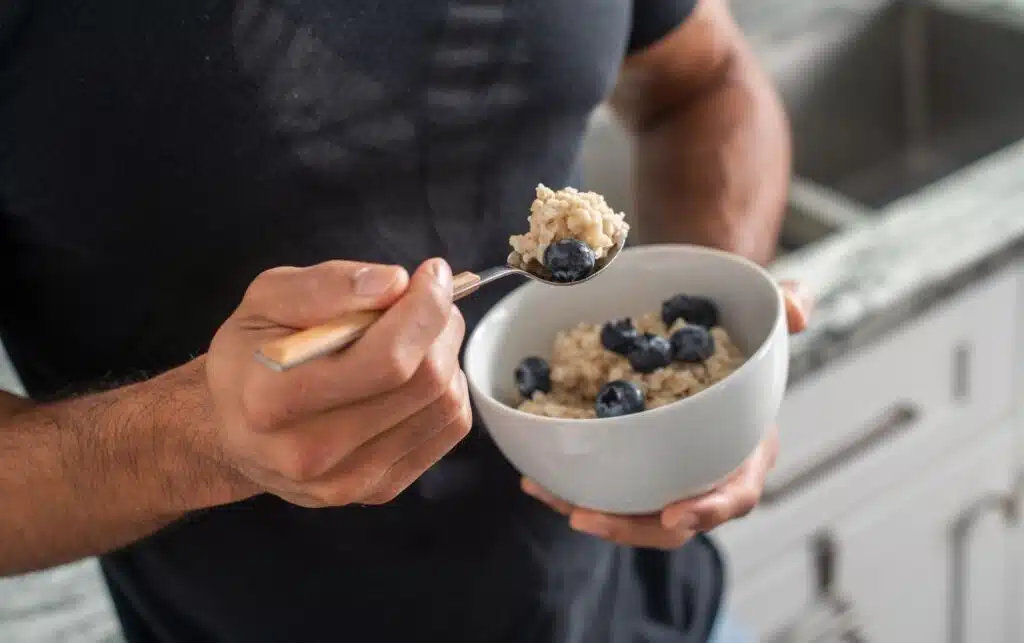Key Takeaways:
- Intermittent fasting is an eating pattern that alternates between periods of eating and fasting.
- Intermittent fasting has been shown to help weight control in overweight and obese adults.
- It has also been shown to help lower insulin levels.
- Choosing a fasting window that aligns with your lifestyle, daily routines, and personal health goals is crucial to ensuring long-term adherence.
- For best results, combine intermittent fasting with healthy eating, proper hydration, adequate sleep, regular exercise, and stress reduction.
Intermittent fasting has been gaining buzz for years. One 2019 study showed that people eating within a 10-hour window and fasting for 14 hours ate 9% fewer calories than normal and some participants in the study experienced weight loss, decreased visceral fat, lower blood pressure, and reduced LDL cholesterol.
Remember, just because this way of eating works for some people, it doesn’t mean it will work for you. Nor does it mean it will be healthy for you. Consult with your physician before starting any new diet regime, including intermittent fasting.
Some people prefer intermittent fasting to other types of diets because it doesn’t tell you what or how much to eat—only when. But does the specific time window you choose to eat matter? Read on to learn whether any particular fasting window of time is better for losing weight or belly fat.
Understanding Intermittent Fasting
Intermittent fasting works by alternating periods of eating and fasting to help reduce calorie intake and can help improve metabolic health.
There are many intermittent fasting methods with different lengths of fasting periods. The shortest intermittent fasting period is typically 10 to 12 hours.
One of the more popular types of intermittent fasting is known as the 16/8 method. That method asks you to fast for 16 hours and eat during an 8-hour window.

Does Intermittent Fasting Help Lose Belly Fat?
Intermittent fasting doesn’t directly target belly fat. Like other weight loss methods, intermittent fasting can help you lose belly fat by creating a caloric deficit that leads to fat loss throughout the body.
Belly fat isn’t a scientific term. It’s an expression that usually refers to comes in two types in the midsection:
- Visceral fat, which surrounds your organs
- Subcutaneous fat, which lies just under the skin
Visceral fat is more harmful and is linked to health issues like heart disease and diabetes. One study using a 16 hour fasting window found a connection to reduction in waist-to-hip ratio and body visceral and subcutaneous body fat.
When you limit your eating window, you’re likely to end up eating less in a day, which in turn helps you decrease your body weight.
Incorporating intermittent fasting into your regular lifestyle could help some lose fat without having to follow a diet that eliminates certain foods or food groups.
Choose the Right Fasting Window for You
Picking the fasting window most suitable for you is all about identifying what fits your lifestyle and health goals. Popular intermittent fasting window options include:
- The 16/8 method, where you fast for 16 hours and eat during an 8-hour window
- The 5:2 method, where you eat normally for five days and restrict calories to about 500-600 for two non-consecutive days
- The 14/10 method, which involves a 14-hour fast followed by a 10-hour eating window
Fasts can be tough to maintain. A JAMA study found that 40% of participants on a fasting diet dropped out. Therefore, choose a window that aligns with when you feel most comfortable eating and fasting.
Experiment with different schedules to see what feels sustainable and suits your lifestyle. Many people are comfortable eating a late breakfast but wouldn’t want to skip family dinner. The right eating plan is one you can maintain, so this really does come down to preference.
Prioritize Healthy Food Choices While Fasting
Making healthy food choices during intermittent fasting is critical for maximizing benefits and maintaining overall health. A balanced diet can help you get the nutrition you need.
During intermittent fasting eating windows, focus on nutrient-dense foods like lean proteins, whole grains, fruits, vegetables, and healthy fats, such as from avocados, nuts, and olive oil. Avoid processed foods, sugary snacks, and excessive refined carbs to prevent energy crashes and blood sugar spikes.
Stay hydrated with water, herbal teas, and black coffee to support your body’s natural processes and avoid dry fasting. Also, your body may sometimes confuse thirst for hunger, making you feel like you haven’t eaten enough.
These tips are extra important when you’re eating in a limited time frame and likely eating less, so pick nourishing food to prevent deficiencies.

Practical Tips for Implementing Intermittent Fasting
Not sure how to go about it? Here are some useful suggestions to help you navigate your intermittent fasting journey.
Be Realistic
Start with a manageable fasting window to ease into the routine. As your body adapts, you can consider increasing the fasting duration to 12 or 14 hours. This gradual approach makes time-restricted eating more sustainable and allows your body to adjust, helping you stick with it as long as needed.
Manage Your Stress
Stress can increase appetite (which means more cravings) and decrease motivation for exercise. All these factors can hinder your fasting results. Techniques like deep breathing, meditation, regular exercise, and staying connected with loved ones help manage stress. Keeping stress under control supports overall health and aids in achieving weight loss goals.
Get Adequate Sleep
Sufficient sleep plays a role in body weight. Quality sleep helps regulate hunger hormones and supports metabolism, which can prevent snacking or cravings that may tempt you to break your fast.
Moreover, sleep deprivation has been associated with increased belly fat. So, improve your sleep by maintaining a consistent bedtime. Avoid heavy meals and caffeine close to bedtime to ensure a restful night and better fasting results.
The Bottom Line: Intermittent Fasting’s Impact on Weight Loss
Intermittent fasting may help aid weight loss by creating calorie deficits and boosting metabolism. Tracking progress with an intermittent fasting tracker helps monitor eating patterns and adherence. Although effective for some, individual responses vary, and integrating fasting with balanced nutrition and exercise remains one of the wisest approaches for sustainable weight management.







